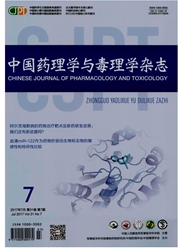

 中文摘要:
中文摘要:
目的探讨孕期尼古丁暴露所致宫内发育迟缓(IUGR)子代大鼠神经内分泌代谢编程改变的跨代遗传效应。方法 Wistar大鼠孕11 d起每天sc给予尼古丁2 mg·kg-1至分娩。子1代(F1)正常组和尼古丁组IUGR交叉配对而得子2代(F2):CC组(亲氏为正常F1)、CN组(父为正常F1,母为IUGR F1)、NC组(父为IUGR F1,母为正常F1)和NN组(亲氏为IUGR F1)。成年F2给予2周冰水游泳刺激,收集刺激前、后血样,采用放免试剂盒检测血清促肾上腺皮质激素(ACTH)水平,ELISA试剂盒检测皮质酮(CORT)水平,生化试剂盒检测葡萄糖、甘油三酯(TG)和总胆固醇(TCH)水平。结果慢性刺激前,NN组雄性子代血清CORT较CC组显著降低,为CC组的73.9%(P〈0.05),CN和NC组雄性子代血清TG分别升高到CC组的1.43和1.52倍(P〈0.05),同时CN,NC和NN组雌性子代血清TG分别升高到CC组的1.71,1.80和1.81倍(P〈0.05);慢性刺激后,CC组雄性子代血清CORT增加率为-1.67%,而NN组雄性子代血清CORT增加率为36.0%,NC组雄性及CN组雌性子代血糖显著升高,分别升高至各自CC对照组的1.61和1.62倍(P〈0.01),同时各尼古丁组雌、雄中子代血清TG增加率均较CC组显著降低(P〈0.05),具体表现为CN,NC和NN组雄性子代血清TG增加率分别降低至CC组的46.4%,16.7%和7.7%,而相应雌性子代血清TG增加率分别降低至CC组的20.6%,4.0%和8.4%。与CC组相比,慢性刺激前,NN组雌、雄性子代血清TCH分别下降40.5%和21.9%(P〈0.01);慢性刺激后,雌性子代TCH增长率升高49.7%(P〈0.05)。结论孕期尼古丁暴露致大鼠神经内分泌代谢编程改变具有跨代遗传效应,且具有一定的性别和亲源性差异。
 英文摘要:
英文摘要:
OBJECTIVE To investigate the transgenerational effect of neuroendocrine metabolic programmed alteration in adult intrauterine growth retardation (lUGR) offspring rats with prenatal nicotine exposure. METHODS Pregnant Wistar rats were administered daily with nicotine (2 mg.kg-1 ) by sc from gestational day 11 until delivery. F1 offspring was fed with a standard diet before four groups in F2 were set up according to the cross-mating between F1 normal adult rats and nicotine-induced lUGR adult rats. CC group was mated by F1 normal adult rats, CN group by F1 normal adult male rats and lUGR adult female rats, NC group by F1 lUGR adult male rats and normal adult female rats, while NN group was mated by F1 lUGR adult rats. F2 adult rats were subjected to a fortnight ice water swimming stimulus. Blood samples were collected before and after stress and then detected for the levels of adrenocortico-tropic hormone ( ACTH), corticosterone ( CORT), glucose, triglycerides ( TG) and total cholesterol (TCH). RESULTS Before stress, the level of serum CORT in F2 male rats of NN group was decreased to 73.9% of that of the CC group (P〈0.05),while the level of serum TG in F2 male rats of CN and NC groups was increased to 1.43 and 1.52 times that of the CC group, respectively ( P〈0.05). Meanwhile, the level of serum TG in F2 female rats of CN, NC and NN groups was increased to 1.71, 1.80 and 1.81 times that of the CC group, respectively (P〈0.05). After stress, the serum CORT gain rate in F2 male rats of CC group was -1.67%, but was 36.0% in NN group. The serum glucose level in male NC group and in female CN group was increased to 1.61 and 1.62 times that of the corresponded CC groups, respectively (P〈0.01). Furthermore, the serum TG gain rate in F2 rats of each nicotine group was decreased markedly in comparison with their corresponding controls (P〈0.05), ie, the serum TG gain rates in F2 male rats of CN, NC and NN groups were decreased to 46.4%, 16.7% and 7.7% of the CC group, whi
 同期刊论文项目
同期刊论文项目
 同项目期刊论文
同项目期刊论文
 期刊信息
期刊信息
